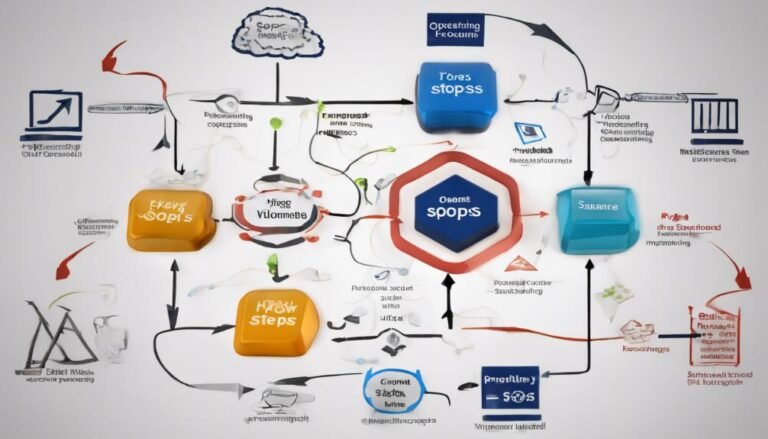Implementing E-commerce Solutions
When implementing e-commerce solutions, prioritize platforms that scale, accommodate traffic spikes, and offer customization. Optimize for mobile, intuitive navigation, and clear calls-to-action to enhance user experience. Carefully select secure payment gateways with fraud protection and seamless integration. Focus on SEO-friendly product listings with high-quality images and logical categorization. Leverage social media, email marketing, and discounts for effective outreach. Implement robust security measures like data encryption and regular audits for customer trust. Enhance user experience with responsive design, fast loading, and detailed product info. Streamline conversions with targeted marketing, streamlined checkout, and A/B testing. These steps guarantee a successful online business presence.
Key Takeaways
- Prioritize functionality, scalability, and customization features for e-commerce platforms.
- Optimize user experience design for mobile devices and intuitive navigation.
- Select secure payment gateways with fraud prevention and seamless integration.
- Focus on product listing optimization with high-quality images and SEO-friendly descriptions.
- Implement marketing integration strategies for promotion and engagement.
Choosing the Right Platform
When selecting an e-commerce platform, prioritize functionality and scalability to secure long-term success for your online business.
Customization options play an important role in guaranteeing that the platform aligns with your brand identity and meets your specific business needs. Look for platforms that offer a wide range of customization features, such as the ability to modify templates, add personalized branding elements, and integrate unique functionalities tailored to your business requirements.
Scalability options are equally significant, especially if you anticipate growth in your online business. Choose a platform that can easily accommodate increased traffic, product listings, and transactions without compromising performance.
Make sure that the platform offers scalability through features like flexible hosting options, efficient data management systems, and the ability to seamlessly integrate additional plugins or extensions as your business expands.
Designing for User Experience
To enhance customer satisfaction and drive conversion rates, meticulous attention to user experience design is paramount when developing an e-commerce website.
Mobile responsiveness is vital in today's digital landscape where a significant portion of online shopping is done via smartphones and tablets. Ensuring that your e-commerce platform is optimized for mobile devices will provide a seamless shopping experience for users on the go.
User-friendly navigation is another key element in designing for a positive user experience. Simple and intuitive navigation menus, search bars, and filters can help customers easily find what they're looking for, reducing frustration and increasing the likelihood of a purchase. Clear categorization and visible call-to-action buttons can guide users through the shopping process smoothly.
Implementing Payment Gateways
You need to carefully consider the payment gateway selection and understand the integration process essentials to guarantee a seamless transaction experience for your customers.
Evaluating factors like security, ease of use, and compatibility with your e-commerce platform are vital in making the right choice.
Payment Gateway Selection
Choosing the right payment gateway is essential for the effective execution of e-commerce solutions. When selecting a payment gateway, two important factors to take into account are fraud prevention and transaction fees. Fraud prevention measures within the payment gateway are crucial to safeguarding your business and customers from potential threats. Look for gateways with robust security features like encryption, tokenization, and Address Verification Service (AVS) to reduce the risk of fraudulent transactions.
Additionally, transaction fees can have a notable impact on your bottom line. Compare the fee structures of different payment gateways, including setup fees, monthly fees, and per-transaction charges. Some gateways offer flat-rate fees, while others have tiered pricing based on transaction volume. Consider your sales volume and average transaction size to choose a pricing model that aligns with your business needs.
Integration Process Essentials
When integrating payment gateways into your e-commerce platform, careful attention to technical specifications and compatibility is crucial for seamless transactions. To guarantee a smooth integration process, begin by evaluating the platform compatibility of the payment gateway with your existing system.
Conduct thorough research on the API integration requirements of the payment gateway to secure a secure and efficient connection.
Data migration is a critical aspect of the integration process. Properly transferring customer information, payment details, and transaction histories is essential for maintaining data integrity and continuity.
Implement rigorous testing protocols to validate the functionality of the payment gateway within your e-commerce platform. Conduct both unit and integration tests to identify and rectify any potential issues before going live.
Optimizing Product Listings
When optimizing your product listings, focus on the importance of high-quality images to attract customers and showcase your products effectively.
Additionally, craft SEO-friendly descriptions that include relevant keywords to improve your search engine visibility and increase traffic to your e-commerce site.
Image Quality Importance
Enhancing the image quality of your product listings is essential for optimizing the visual appeal and effectiveness of your e-commerce platform. High-quality images not only attract customers but also play an important role in representing your brand identity and engaging users through visual storytelling.
When it comes to image optimization, focus on high-resolution pictures that showcase your products from different angles. This attention to detail can greatly enhance customer engagement and trust in your brand. Additionally, utilizing images that align with your brand's visual storytelling can create a cohesive and memorable shopping experience for your visitors.
Below is a table highlighting the key aspects of image quality importance in e-commerce:
| Aspect | Description | Benefits |
|---|---|---|
| High-Resolution | Clear and detailed images | Enhanced customer engagement |
| Brand Consistency | Align with brand identity | Establishes brand trust |
| Multiple Angles | Show products from all sides | Improved product perception |
SEO-Friendly Descriptions
To optimize your e-commerce platform for search engines, crafting SEO-friendly descriptions for your product listings is essential. Conducting thorough keyword research is the first step in creating descriptions that resonate with search algorithms and potential customers. By understanding the terms and phrases your target audience uses, you can tailor your content to drive organic traffic to your site.
Once you have identified relevant keywords, integrating them strategically into your product descriptions is important. Aim to provide valuable information while naturally incorporating these keywords to enhance your search engine visibility. Additionally, optimizing metadata such as title tags and meta descriptions can further boost your product listings' SEO performance.
Effective product categorization is another significant aspect of SEO-friendly descriptions. Organizing your products into logical categories not only improves the user experience but also helps search engines understand the structure of your website.
Integrating Marketing Strategies
How can you effectively integrate marketing strategies into your e-commerce solutions to maximize customer engagement and drive sales?
Integrating social media and email marketing into your e-commerce platform can greatly boost your online presence and revenue. Begin by leveraging social media platforms such as Facebook, Instagram, and Twitter to promote your products, engage with customers, and drive traffic to your e-commerce site. Create compelling content, run targeted ads, and collaborate with influencers to expand your reach and attract potential customers.
Incorporating email marketing is another powerful strategy to enhance customer relationships and increase sales. Develop personalized email campaigns to nurture leads, promote new products, and offer exclusive discounts to incentivize purchases. Implement automated workflows to send relevant content based on customer behavior, preferences, and purchase history. Utilize catchy subject lines, visually appealing designs, and clear call-to-actions to encourage clicks and conversions.
Ensuring Security Measures
What key security measures should be implemented to safeguard your e-commerce platform and protect customer data effectively? When it comes to guaranteeing the security of your e-commerce platform, two vital measures to focus on are data encryption and fraud prevention. Data encryption plays an essential role in protecting sensitive information by converting it into a code that can only be deciphered with the correct encryption key. This ensures that even if data is intercepted, it remains unreadable to unauthorized parties. In parallel, fraud prevention measures are essential to detect and mitigate any fraudulent activities that could compromise your platform's integrity and your customers' trust.
To provide a clearer overview, below is a table summarizing the key security measures for your e-commerce platform:
| Security Measure | Description |
|---|---|
| Data Encryption | Converts sensitive data into a code for secure transmission. |
| Fraud Prevention | Detects and prevents fraudulent activities on the platform. |
Conclusion
As you navigate the world of e-commerce solutions, remember that success is like building a sturdy ship. Each platform choice, user experience design, payment gateway, product listing, and marketing strategy is an essential piece of the vessel.
By carefully implementing these components and ensuring security measures, you can set sail towards a successful online business. Just as a ship needs every part working together to stay afloat, your e-commerce venture relies on the harmonious integration of these elements.
Sail on, captain.








